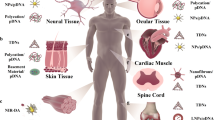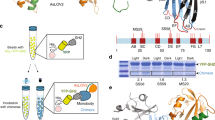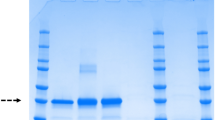Abstract
Split-protein systems, an approach that relies on fragmentation of proteins with their further conditional re-association to form functional complexes, are increasingly used for various biomedical applications. This approach offers tight control of protein functions and improved detection sensitivity. Here we report a similar technique based on a pair of RNA–DNA hybrids that can be used generally for triggering different split functionalities. Individually, each hybrid is inactive but when two cognate hybrids re-associate, different functionalities are triggered inside mammalian cells. As a proof of concept, this work mainly focuses on the activation of RNA interference. However, the release of other functionalities (such as resonance energy transfer and RNA aptamer) is also shown. Furthermore, in vivo studies demonstrate a significant uptake of the hybrids by tumours together with specific gene silencing. This split-functionality approach presents a new route in the development of ‘smart’ nucleic acid-based nanoparticles and switches for various biomedical applications.
This is a preview of subscription content, access via your institution
Access options
Subscribe to this journal
Receive 12 print issues and online access
$259.00 per year
only $21.58 per issue
Buy this article
- Purchase on Springer Link
- Instant access to full article PDF
Prices may be subject to local taxes which are calculated during checkout






Similar content being viewed by others
References
Johnsson, N. & Varshavsky, A. Split ubiquitin as a sensor of protein interactions in vivo. Proc. Natl Acad. Sci. USA 91, 10340–10344 (1994).
Cassonnet, P. et al. Benchmarking a luciferase complementation assay for detecting protein complexes. Nature Methods 8, 990–992 (2011).
Shekhawat, S. S. & Ghosh, I. Split-protein systems: beyond binary protein–protein interactions. Curr. Opin. Chem. Biol. 15, 789–797 (2011).
Guo, P. The emerging field of RNA nanotechnology. Nature Nanotech. 5, 833–842 (2010).
Pecot, C. V., Calin, G. A., Coleman, R. L., Lopez-Berestein, G. & Sood, A. K. RNA interference in the clinic: challenges and future directions. Nature Rev. Cancer 11, 59–67 (2011).
Davis, M. E. The first targeted delivery of siRNA in humans via a self-assembling, cyclodextrin polymer-based nanoparticle: from concept to clinic. Mol. Pharm. 6, 659–668 (2009).
Shukla, G. C. et al. A boost for the emerging field of RNA nanotechnology. ACS Nano 5, 3405–3418 (2011).
Afonin, K. A. et al. Design and self-assembly of siRNA-functionalized RNA nanoparticles for use in automated nanomedicine. Nature Protoc. 6, 2022–2034 (2011).
Shu, Y., Cinier, M., Shu, D. & Guo, P. Assembly of multifunctional phi29 pRNA nanoparticles for specific delivery of siRNA and other therapeutics to targeted cells. Methods 54, 204–214 (2011).
Davis, M. E. et al. Evidence of RNAi in humans from systemically administered siRNA via targeted nanoparticles. Nature 464, 1067–1070 (2010).
Fire, A. et al. Potent and specific genetic interference by double-stranded RNA in Caenorhabditis elegans. Nature 391, 806–811 (1998).
Singh, S., Narang, A. S. & Mahato, R. I. Subcellular fate and off-target effects of siRNA, shRNA, and miRNA. Pharm. Res. 28, 2996–3015 (2011).
Sashital, D. G. & Doudna, J. A. Structural insights into RNA interference. Curr Opin. Struct. Biol. 20, 90–97 (2010).
Rana, T. M. Illuminating the silence: understanding the structure and function of small RNAs. Nature Rev. 8, 23–36 (2007).
Jinek, M. & Doudna, J. A. A three-dimensional view of the molecular machinery of RNA interference. Nature 457, 405–412 (2009).
Hannon, G. J. & Rossi, J. J. Unlocking the potential of the human genome with RNA interference. Nature 431, 371–378 (2004).
Meister, G. & Tuschl, T. Mechanisms of gene silencing by double-stranded RNA. Nature 431, 343–349 (2004).
Berkhout, B. & Sanders, R. W. Molecular strategies to design an escape-proof antiviral therapy. Antiviral Res. 92, 7–14 (2011).
Kim, D. H. et al. Synthetic dsRNA Dicer substrates enhance RNAi potency and efficacy. Nature Biotechnol. 23, 222–226 (2005).
Rose, S. D. et al. Functional polarity is introduced by Dicer processing of short substrate RNAs. Nucleic Acids Res. 33, 4140–4156 (2005).
Doi, N. et al. Short-interfering-RNA-mediated gene silencing in mammalian cells requires Dicer and eIF2C translation initiation factors. Curr. Biol. 13, 41–46 (2003).
Zhang, H., Kolb, F. A., Brondani, V., Billy, E. & Filipowicz, W. Human Dicer preferentially cleaves dsRNAs at their termini without a requirement for ATP. EMBO J. 21, 5875–5885 (2002).
Chiu, Y. L. & Rana, T. M. siRNA function in RNAi: a chemical modification analysis. RNA 9, 1034–1048 (2003).
Elbashir, S. M., Martinez, J., Patkaniowska, A., Lendeckel, W. & Tuschl, T. Functional anatomy of siRNAs for mediating efficient RNAi in Drosophila melanogaster embryo lysate. EMBO J. 20, 6877–6888 (2001).
Parrish, S., Fleenor, J., Xu, S., Mello, C. & Fire, A. Functional anatomy of a dsRNA trigger: differential requirement for the two trigger strands in RNA interference. Mol. Cell 6, 1077–1087 (2000).
Zhang, D. Y., Turberfield, A. J., Yurke, B. & Winfree, E. Engineering entropy-driven reactions and networks catalyzed by DNA. Science 318, 1121–1125 (2007).
Hoerter, J. A., Krishnan, V., Lionberger, T. A. & Walter, N. G. siRNA-like double-stranded RNAs are specifically protected against degradation in human cell extract. PLoS ONE 6, e20359 (2011).
Low, J. T. et al. SHAPE-directed discovery of potent shRNA inhibitors of HIV-1. Mol. Ther. 20, 820–828 (2012).
Townsend, D. M. & Tew, K. D. The role of glutathione-S-transferase in anti-cancer drug resistance. Oncogene 22, 7369–7375 (2003).
Zuker, M. Mfold web server for nucleic acid folding and hybridization prediction. Nucleic Acids Res. 31, 3406–3415 (2003).
Wallace, R. B. et al. Hybridization of synthetic oligodeoxyribonucleotides to phi chi 174 DNA: the effect of single base pair mismatch. Nucleic Acids Res. 6, 3543–3557 (1979).
Sugimoto, N. et al. Thermodynamic parameters to predict stability of RNA/DNA hybrid duplexes. Biochemistry 34, 11211–11216 (1995).
Zadeh, J. N. et al. NUPACK: analysis and design of nucleic acid systems. J. Comput. Chem. 32, 170–173 (2010).
Grabow, W. W. et al. Self-assembling RNA nanorings based on RNAI/II inverse kissing complexes. Nano Lett. 11, 878–887 (2011).
Afonin, K. A. et al. Co-transcriptional assembly of chemically modified RNA nanoparticles functionalized with siRNAs. Nano Lett. 12, 5192–5195 (2012).
Berney, C. & Danuser, G. FRET or no FRET: a quantitative comparison. Biophys. J. 84, 3992–4010 (2003).
Bramsen, J. B. et al. Improved silencing properties using small internally segmented interfering RNAs. Nucleic Acids Res. 35, 5886–5897 (2007).
Grate, D. & Wilson, C. Laser-mediated, site-specific inactivation of RNA transcripts. Proc. Natl Acad. Sci. USA 96, 6131–6136 (1999).
Baugh, C., Grate, D. & Wilson, C. 2.8 Å crystal structure of the malachite green aptamer. J. Mol. Biol. 301, 117–128 (2000).
Stojanovic, M. N. & Kolpashchikov, D. M. Modular aptameric sensors. J. Am. Chem. Soc. 126, 9266–9270 (2004).
Afonin, K. A., Danilov, E. O., Novikova, I. V. & Leontis, N. B. TokenRNA: a new type of sequence-specific, label-free fluorescent biosensor for folded RNA molecules. Chembiochem 9, 1902–1905 (2008).
Afonin, K. A. et al. In vitro assembly of cubic RNA-based scaffolds designed in silico. Nature Nanotech. 5, 676–682 (2010).
Shu, D., Shu, Y., Haque, F., Abdelmawla, S. & Guo, P. Thermodynamically stable RNA three-way junction for constructing multifunctional nanoparticles for delivery of therapeutics. Nature Nanotech. 6, 658–667 (2011).
Chworos, A. et al. Building programmable jigsaw puzzles with RNA. Science 306, 2068–2072 (2004).
Dibrov, S. M., McLean, J., Parsons, J. & Hermann, T. Self-assembling RNA square. Proc. Natl Acad. Sci. USA 108, 6405–6408 (2011).
Venkataraman, S., Dirks, R. M., Ueda, C. T. & Pierce, N. A. Selective cell death mediated by small conditional RNAs. Proc. Natl Acad. Sci. USA 107, 16777–16782 (2010).
Afonin, K. A., Lin, Y. P., Calkins, E. R. & Jaeger, L. Attenuation of loop-receptor interactions with pseudoknot formation. Nucleic Acids Res. 40, 2168–2180 (2012).
Afonin, K. A. & Leontis, N. B. Generating new specific RNA interaction interfaces using C-loops. J. Am. Chem. Soc. 128, 16131–16137 (2006).
Kim, T. J. et al. In silico, in vitro and in vivo studies indicate the potential use of bolaamphiphiles for therapeutic siRNAs delivery. Mol. Ther.–Nucleic Acids 2, e1 (2013).
Waheed, A. A., Ono, A. & Freed, E. O. Methods for the study of HIV-1 assembly. Methods Mol. Biol. 485, 163–184 (2009).
Acknowledgements
K.A.A. dedicates this work to T. Vinogradova and V. Vinogradov. The authors thank M.A. Dobrovolskaia from the Nanotechnology Characterization Laboratory for critical reading and helping to address some of the reviewers’ concerns. The authors also thank N. Patel, L. Riffle and J. Kalen in the Small Animal Imaging Program at the Frederick National Laboratory for Cancer Research for their guidance and support in animal imaging. The authors acknowledge help with ex vivo imaging from the Pathology Histology Laboratory of SAIC-Frederick at the Frederick National Laboratory for Cancer Research Thanks also go to C.J. Westlake at the Frederick National Laboratory for Cancer Research for providing plasmids expressing GFP-Rab5 or GFP-Rab7. The authors thank P.S. Steeg at the National Cancer Institute for providing GFP-expressing cells for in vivo experiments. This research was supported (in part) by the Intramural Research Program of the NIH, National Cancer Institute, Center for Cancer Research. This work was funded, in whole or in part, by Federal funds from the Frederick National Laboratory for Cancer Research, NIH (contract no. HHSN261200800001E). The content of this publication does not necessarily reflect the views or policies of the Department of Health and Human Services, nor does mention of trade names, commercial products or organizations imply endorsement by the US Government. This research was also supported by an NIH grant (no. R01GM-079604 to L.J.).
Author information
Authors and Affiliations
Contributions
K.A.A. and B.A.S. designed the project. K.A.A., M.V., B.A.S., A.N.M. and E.O.F. conceived and designed the experiments. K.A.A. performed all sequence designs and assemblies, Dicer assay experiments and human serum degradation studies. K.A.A. and M.V. performed all in vitro fluorescent studies and related cell transfections. K.A.A., M.V. and S.J.L. performed microscopy experiments and related analysis. R.B., M.V. and K.A.A. determined the kinetics. K.A.A., M.V., A.N.M. and A.E.M. carried out all silencing experiments. K.A.A. and M.V. contributed to in vivo and ex vivo studies and data analysis. E.H. provided material for in vivo studies. K.A.A., M.V., A.N.M., A.E.M. E.O.F., L.J., S.J.L. and B.A.S. analysed data. K.A.A., M.V., B.A.S., A.N.M. and E.O.F. co-wrote the paper.
Corresponding author
Ethics declarations
Competing interests
The authors declare no competing financial interests.
Supplementary information
Rights and permissions
About this article
Cite this article
Afonin, K., Viard, M., Martins, A. et al. Activation of different split functionalities on re-association of RNA–DNA hybrids. Nature Nanotech 8, 296–304 (2013). https://doi.org/10.1038/nnano.2013.44
Received:
Accepted:
Published:
Issue Date:
DOI: https://doi.org/10.1038/nnano.2013.44



